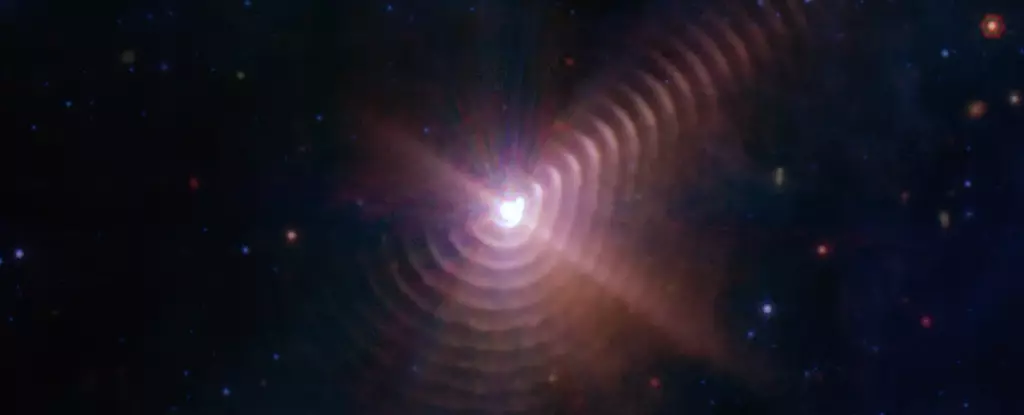In the grand expanse of our universe, elemental particles drift across the celestial planes, slowly aggregating into forms that form the building blocks for life and rocky planets. This cosmic dust, often rich in carbon, plays a crucial role in the evolutionary narrative of the universe. It emerges from various astrophysical processes, including the death throes of stars, and the stellar winds generated by intense stellar interactions. However, for astronomers armed with telescopes seeking to uncover the mysteries of the cosmos, this same dust becomes an obstacle that obscures their observations. To combat this, the James Webb Space Telescope (JWST) was engineered with advanced infrared capabilities designed to penetrate these clouds of cosmic soot, revealing deeper insights into stellar phenomena.
Among the myriad of celestial objects, the Wolf-Rayet binary star system WR 140 stands out as a prime subject of study. Located approximately 5,000 light-years away in the constellation of Cygnus, WR 140 consists of two massive stars that participate in an energetic dance every 7.93 years. During this cosmic waltz, known as periastron, the stars’ stellar winds collide, fostering a tumultuous environment ripe for dust creation. In a study published in 2022, researchers unveiled intricate details about this binary system, highlighting its significance as a laboratory for investigating the formation of carbon-rich dust. They noted that understanding the chemical composition of this dust and its survival mechanisms is paramount, especially given the potential these stellar interactions hold for enriching the interstellar medium.
Understanding the Mechanisms of Dust Formation
At the core of dust formation in systems like WR 140 is the interplay of chemically rich winds from the two stars. The more massive Wolf-Rayet star and its companion, an OB star, collide at periastron, compressing the gases and triggering dust formation. This is a cyclic phenomenon, where dust is expelled in discrete rings as the stars come close to each other. Before the JWST’s advanced observational capabilities, astronomers had limited insight into the ongoing nature of these processes, primarily due to the slow timescales typically associated with cosmic phenomena. However, the unique attributes of WR 140—its predictable dust-formation episodes every 7.93 years—allow for more immediate studies of stellar interactions.
The latest observations from the JWST further elevate our understanding of WR 140. After capturing its complexity for the first time in 2022, the telescope revisited the binary system 14 months later, revealing stark changes in the dust rings. Emma Lieb, a lead author on the new findings, reported that the continued expansion of these dust shells occurs at consistent velocities, manifesting visible changes within remarkably short timeframes. This rapid evolution is a rarity in astrophysics and provides invaluable real-time data about how stellar winds shape cosmic dust formations across time.
Co-author Jennifer Hoffman emphasized the significance of these observations: “In this system, the observatory is showing that the dust shells are expanding from one year to the next.” Such findings challenge the conventional perception of slow cosmic processes and underscore the dynamic nature of celestial interactions occurring within our universe.
The Implications of Dust Creation
The persistent dust generation in WR 140 is not merely a cosmic curiosity; it holds profound implications for understanding the broader universe. Dust formed in such scenarios is suspected to contribute to the genesis of carbonaceous material essential for life. Astronomers are beginning to unravel the role of massive binaries like WR 140 as potential “factories of dust,” as noted by Olivia Jones, co-author at the UK Astronomy Technology Centre. The data from JWST holds the potential to illuminate not just how stars create dust but also how such materials may nestle into the fabric of future star formation, possibly seeding new planetary systems.
Although the current cycle of dust generation in WR 140 continues, astronomers must also contemplate the fate of these massive stars. Typically, WR stars end their life cycles in spectacular supernova explosions, with some remnants collapsing into black holes. The timeline for WR 140’s ultimate demise remains speculative, but its ongoing life provides a captivating glimpse into the processes that generate the very dust particles that may one day harbor the seeds of life itself.
The captivating dance of stars in systems like WR 140 presents a vivid tableau of cosmic creation and destruction. The JWST’s pioneering observations allow us to witness the real-time evolution of dust over brief epochs, offering exciting possibilities for future research. Ultimately, as we probe deeper into the cosmos, we uncover not just the origins of matter but also the intricate web of connections that bind the universe together—a lesson in the delicate balance of creation and decay, and the potential for life amidst the stars.

